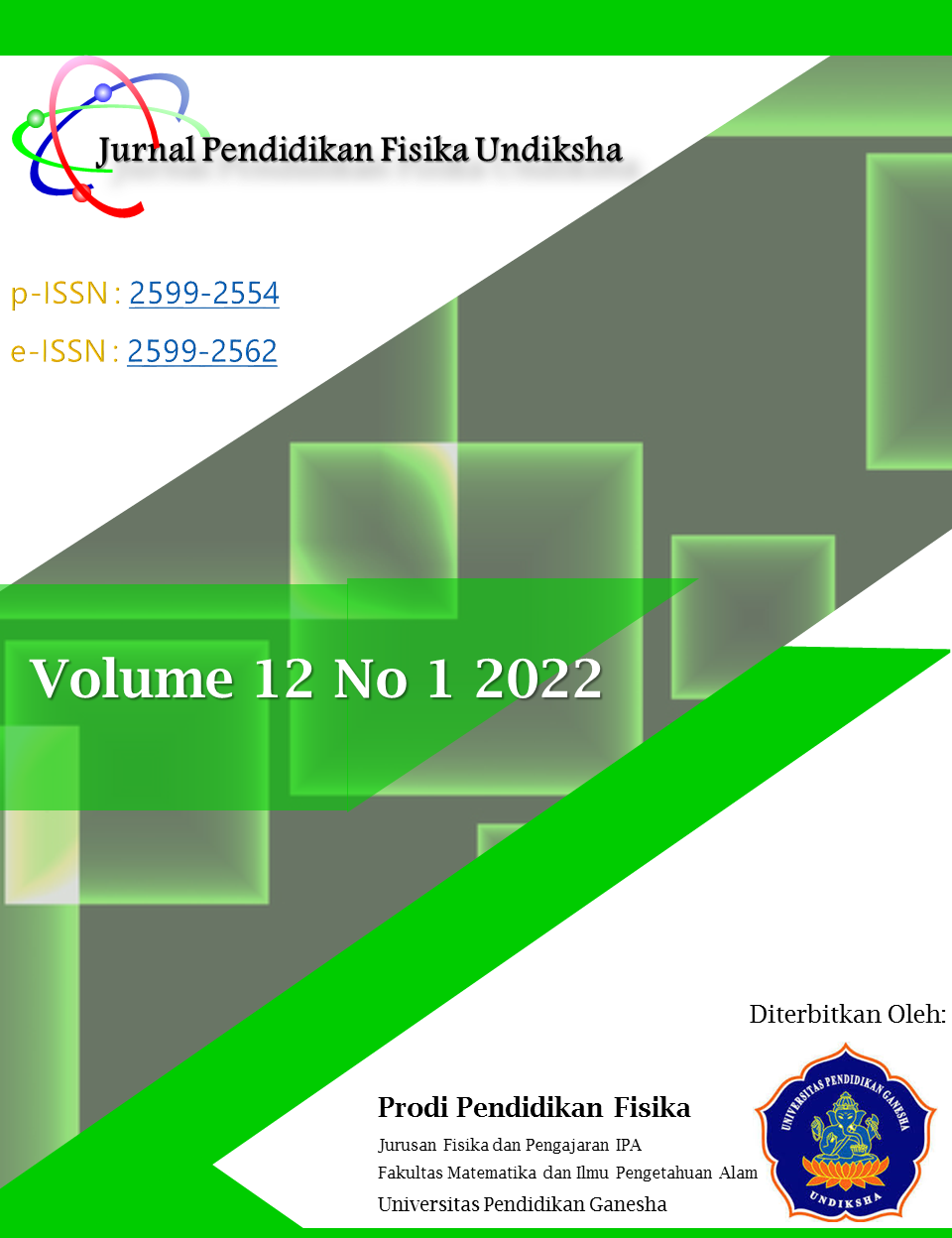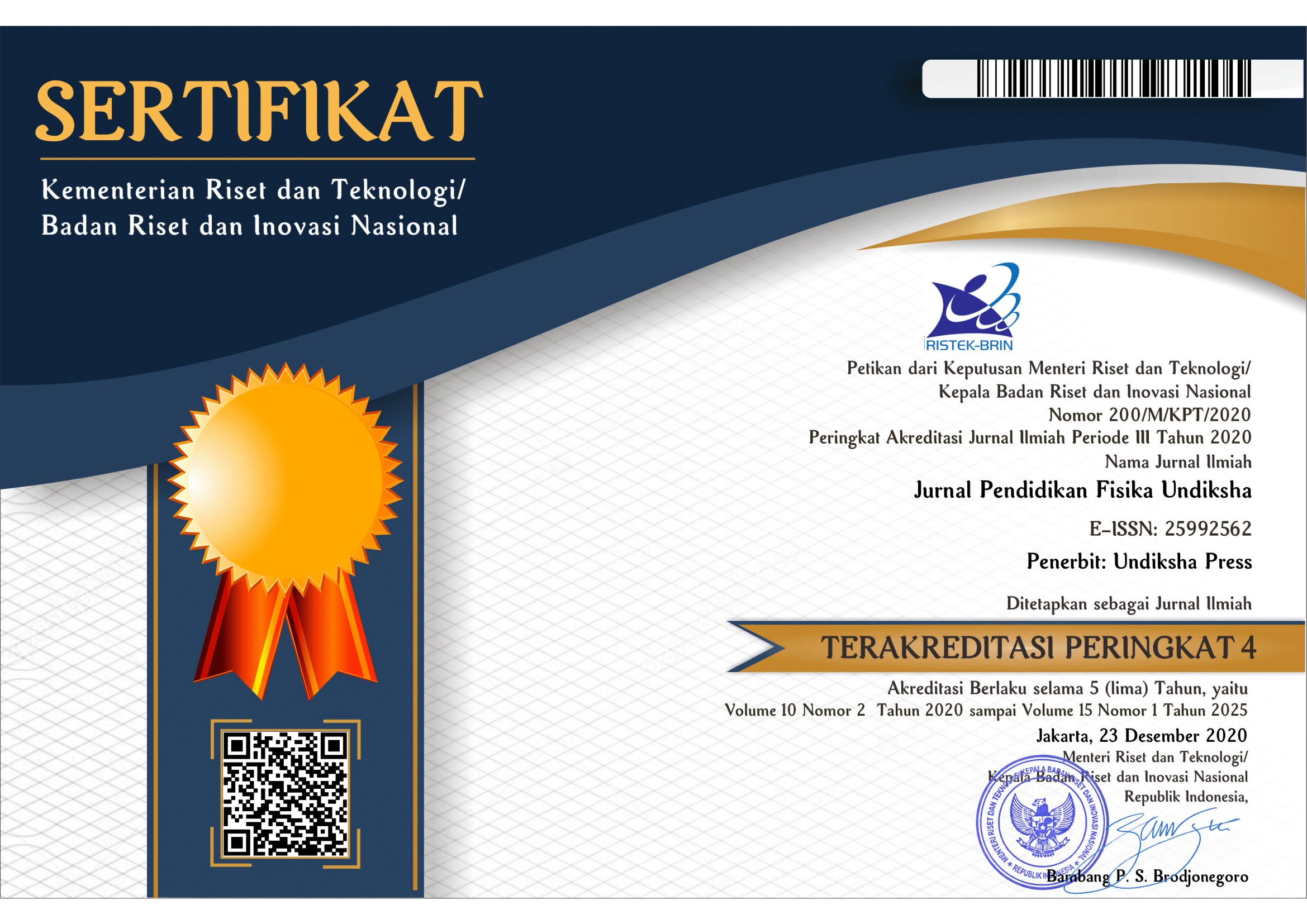IMPROVING STUDENTS’ ACTIVITY AND CONCEPTUAL UNDERSTANDING BY AN IMPLEMENTATION OF PHYSICS INTERACTIVE MULTIMEDIA-ASSISTED GROUP INVESTIGATION MODEL
DOI:
https://doi.org/10.23887/jjpf.v12i1.46521Keywords:
conceptual understanding, learning acivity, PhIMPAbstract
Conceptual understanding is the main competency that must be possessed by students when participating in physics learning. This study aims to improve students' learning activity and conceptual understanding of physic in class XA Pharmacy at SMK Bintang Persada Denpasar on the subject of Elasticity and Static Fluid through online group investigation. This learning uses PhIMP (Physics Interactive Multimedia Packaging). PhIMP-assisted online group investigation is unique because students learn comprehensively and deeply about basic physics concepts through online experimental activities, group discussions, and online presentations. This research was a classroom action research that involved 31 students. It was implemented in two cycles. Student’s learning activity and conceptual understanding is a variable studied. The instruments used a conceptual understanding test that consists of 30 items and a learning activity observation sheet. The data were collected using pre-test and post-test technique in each learning cycle. The results indicate that there is an increase in student learning activities from cycle I to cycle II. The average score of student learning activities for the cycle I and cycle II were 35.5 and 48.5, respectively. There is an improvement in student’s conceptual understanding. The N-gain scores in cycle I and cycle II were 0.39 and 0.71. There is also an improvement in the dimensions of conceptual understanding abilities. These results indicate that theinteractive multimedia-assisted group investigation model is powerful to facilitate students in improving their activity and conceptual understanding.References
Abdjul, T., Ntobuo, N. E., & Payu, C. 2019. Development of Virtual Laboratory-Based of Learning to Improve Physics Learning Outcomes of High School Students. Jurnal Pendidikan Fisika Indonesia, 15(2), 97–106. https://doi.org/10.15294/jpfi.v15i2.12367.
Achufusi, N. N., Utakaja, N., Onuh, C. C., & Okonkwoe, O. 2019. Secondary School Students ’ Self Efficacy and Motivation as Correlates of Their Achievement in Physics. IOSR Journal of Research & Method in Education, 9(3), 75–80. https://doi.org/10.9790/1959-0903017580.
Afriani, T., Agustin, R. R., & Eliyawati. 2019. The Effect of Guided Inquiry Laboratory Activity with Video Embedded on Students ’ Understanding and Motivation in Learning Light and Optics. Journal of Science Learning, 2(3), 79–84. https://doi.org/10.17509/jsl.v2i3.15144.
Al-amri, A., Osman, M., & Musawi, A. A. 2020. The Effectiveness of a 3D-Virtual Reality Learning Environment (3D-VRLE) on the Omani Eighth Grade Students ’ Achievement and Motivation towards Physics Learning. International Journal of Educational Technology, 15(5), 1–16. https://doi.org/10.3991/ijet.v15i05.11890.
Aljuhani, K., Sonbul, M., Althabiti, M., & Meccawy, M. 2018. Creating a Virtual Science Lab (VSL): the Adoption of Virtual Labs in Saudi Schools. Smart Learning Environments, 5(16), 1–13. https://doi.org/10.1186/s40561-018-0067-9.
Alneyadi, S. S. 2019. Virtual Lab Implementation in Science Literacy : Emirati Science Teachers ’ Perspectives. EURASIA Journal of Mathematics, Science and Technology Education, 15(12), 1–10. https://doi.org/10.29333/ejmste/109285.
Anderson, L. W., Krathwohl, D. R., Airasian, P. W., Cruikshank, K. A., Mayer, R. E., Pintrich, P. R., Raths, J., & Wittrock, M. C. 2001. A Taxonomy for Learning, Teaching, and Assessing: A Revision of Bloom’s Taxonomy of Educational Objectives. Pearson Education.
Arinda, Y., Wilujeng, I., & Kuswanto, H. 2019. The Application Group Investigation (GI) Learning Model assisted Phet to Facilitate Student Scientific Work Skills. International Journal of Educational Research Review, 4(2), 254–261. https://doi.org/10.24331/ijere.518069.
Atanas, J. P. 2018. Is Virtual-Physical or Physical-Virtual Manipulatives in Physics Irrelevant Within Studio Physics Environment ? Athens Journal of Education, 5(1), 29–42. https://doi.org/10.30958/aje.5-1-2.
Billah, A., & Widiyatmoko, A. 2018. The Development of Virtual Laboratory Learning Media for the Physical Optics Subject. Jurnal Ilmiah Pendidikan Fisika Al-Biruni, 07(2), 153–160. https://doi.org/10.24042/jipfalbiruni.v7i2.2803.
Bogusevschi, D., Muntean, C. H., & Muntean, G. M. 2020. Teaching and Learning Physics Using 3D Virtual Learning Environment : A Case Study of Combined Virtual Reality and Virtual Laboratory in Secondary School. Journal of Computers in Mathematics and Science Teaching, 39(1), 5 – 18. https://www.learntechlib.org/p/210965.
Chan, Y. L., & Norlizah, C. H. 2017. Students ’ Motivation Towards Science Learning and Students ’ S cience Achievement. International Journal of Academic Research in Progressive Education and Development, 6(4), 174–189. https://doi.org/10.6007/IJARPED/v6-i4/3716.
Faour, M. A., & Ayoubi, Z. 2018. The Effect of Using Virtual Laboratory on Grade 10 Students ’ Conceptual Understanding and their Attitudes towards Physics To cite this article : The Effect of Using Virtual Laboratory on Grade 10 Students ’ Conceptual Understanding and their Attitudes to. Journal of Education in Science, Environment and Health, 4(1), 54–68. https://doi.org/10.21891/jeseh.387482.
Gunawan, G., Nisrina, N., Suranti, N. M. Y., Herayanti, L., & Rahmatian, R. 2018. Virtual Laboratory to Improve Students ’ Conceptual Understanding in Physics Learning Virtual Laboratory to Improve Students ’ Conceptual Understanding in Physics Learning. Journal of Physics: Conference Series, 1–6. https://doi.org/10.1088/1742-6596/1108/1/012049.
Gunawan, Harjono, A., Sahidu, H., & Herayanti, L. 2017. Virtual Laboratory of Electicity Concept to Improve Prospective Physics Teachers ’ Creativity. Jurnal Ilmiah Pendidikan Fisika Al-Biruni, 13(2), 102–111. https://doi.org/10.15294/jpfi.v13i2.10152.
Haji, A. G., Safriana, & Safritri, R. 2015. The Use of Problem Based Learning to Increase Students ’ Learning Independent and to Investigate Students ’ Concept Understanding on Rotational Dyanamic at Students of SMA Negeri 4 Banda Aceh. Jurnal Pendidikan IPA Indonesia, 4(1), 67–72. https://doi.org/10.15294/jpii.v4i1.3503.
Harahap, R. A., & Derlina. 2017. Pembelajaran Kooperatif Tipe Group Investigation (GI) dengan Metode Know-Want-Learn (KWL): Dampak Terhadap Hasil Belajar Fluida Dinamis. Jurnal Ilmiah Pendidikan Fisika Al-Biruni, 6(2), 149–158. https://doi.org/10.24042/jipfalbiruni.v6i2.1369.
Maulidah, S. S., & Prima, E. C. 2018. Using Physics Education Technology as Virtual Laboratory in Learning Waves and Sounds. Journal of Science Learning, 1(3), 116–121. https://doi.org/10.17509/jsl.v1i3.11797.
Ratamun, M. M., & Osman, K. 2018. The Effectiveness Comparison of Virtual Laboratory and Physical Laboratory in Nurturing Student’s Attitude Toward Chemistry. Creative Education, 09(9), 1411-1425. https://doi.org/10.4236/ce.2018.99105.
Saleh, S. 2014. Malaysian Students’ Motivation Towards Physics Learning. European Journal of Science and Mathematics Education, 2(4), 223–232.
Santyasa, I. W., Kanca, I. N., Warpala, I. W., & Sudarma, I. K. 2019. Group Investigation and Explicit Learning Models in Learning Physics at Senior High Schools. Jurnal Penelitian dan Pengembangan Pendidikan Fisika, 5(2), 203–216. https://doi.org/10.21009/1.05216.
Sari, N., Sunarno, W., & Sarwanto, S. 2017. Senior High School Learning Motivation on Physics Subject. Jurnal Pendidikan Dan Pembelajaran, 24(1), 1–6. https://journal2.um.ac.id/index.php/jpp/article/view/6815.
Suhartono, Degeng, I. N. S., Suyitno, I., & Sulton. 2019. A Comparison Study : Effects of the Group Investigation Model and the Direct Instruction Model Toward Science Concept Understanding. Jurnal Pendidikan IPA Indonesia, 8(2), 185–192. https://doi.org/10.15294/jpii.v8i2.18135.
Tirta, G. A. R., Prabowo, P., & Kuntjoro, S. 2019. Implementation of Cooperative Learning Group Investigation to Improve Students Self-Efficacy and Learning Achievement on Statics Fluid. Journal of Physics: Conference Series, 1–7. https://doi.org/10.1088/1742-6596/1157/3/032008.
Tirta, G. A. R., Prabowo, P., & Kuntjro, S. 2018. Development of Physics Teaching Instruments Belong to Cooperative Group Investigation Model to Improve Students ’ Self -Efficacy and Learning Achievement. Jurnal Penelitian Pendidikan Sains, 8(1), 1464–1471. https://doi.org/10.26740/jpps.v7n2.
Yuliani, N. 2019. The Role of Student Teams Achievement Divisions (STAD) in Improving Student’s Learning Outcomes. Classroom Action Research Journal, 3(1), 8–15. https://doi.org/10.17977/um013v3i12019p008.
Downloads
Published
Issue
Section
License
Copyright (c) 2022 Jurnal Pendidikan Fisika Undiksha

This work is licensed under a Creative Commons Attribution-ShareAlike 4.0 International License.

Jurnal Pendidikan Fisika Undiksha is licensed under a Creative Commons Attribution-ShareAlike 4.0 International License.







